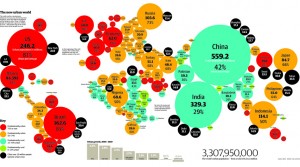I’ve always been excited by ‘the future’. Not in the flagrantly personal style of the crystal-ball, but rather in the “it-barely-exists-on-the-fringe-now-but-it’s-so-cool-let’s-see-what-can-we-do-with-it” sense. As an example I would point you towards our foray into virtual worlds, exciting, but…as it’s still a bit painful for me, I’ll just stand far back and point in its general direction— (it’s all out there for you to find if you are interested).
Anywho, in the last few months I’ve run across three things that have captured my attention about the future, made me think and have created that happy-wiggly-puppy-dog feeling of excitement in how they all converge—they are: 11-year olds, Re-Urbanization and New Currency.
11-Year Olds and A Coming New Age
A few weeks ago my 11 year-old graduated from elementary school. Leading up to this, their teachers had gotten together and discussed every child, ultimately deciding what each would become in the future based on who they were now. It was an interesting look at what the future could be based upon the character and capabilities of barely-formed human beings. Bottom line is that if each 11 year-old in the world was like these here in Austin we will soon find ourselves transitioning from the Information Age to some sort of (for lack of a better name) Neo-Industrious Age.Now Daniel Pink, in his book, A Whole New Mind, postulated in 2005 that we have already left the Information Age and have entered the Conceptual Age, the age of creation and empathy where jobs will require new and distinct capabilities, specifically 7 of them: care, humor, imagination, ingenuity, instinct, joyfulness and personal rapport, or social dexterity—all in all, not that different than how our 11-year olds were described.
While I agree with Pink that the Information Age has waned, I’m not sold on the idea of a Conceptual Age. I’m intrigued by what is essentially an “Innovation Age with Purpose”, and agree with the idea that our own humanity in the face of overwhelming digitalness will push us back towards characteristics like care, instinct and personal rapport, but it misses the mark in one key area: the hands-on intent of craftsmanship. Yes, there will be innovation, but I think we have been burned out by innovation and progress on such a large scale that we will ultimately pull back to an artisanal mode, where innovation flourishes on a smaller, community scale—the Etsy model, if you will—innovations from a series of smaller leaps instead of one giant one.
I hold up John Lehrer and his book, Proust was a Neuroscientist, surprisingly, as part of my reasoning. Usually I only have to hear the name “Proust” and I fall over dead. But for some reason this book caught me a few years ago and on a dismal and boring day in the Cleveland airport, I read it cover to cover. However, when Lehrer looked at a poet, four novelists, a chef, a painter and a composer and saw a link between neuroscience and ideas, I simply saw industrious individuals who through their art created small, personal innovations that impacted our culture on a large scale. This wasn’t a person like Gates or Jobs creating a billion new things that took over the world, rather this was a person creating one thing that then impacted another and another….think of Blind Willie Johnson innovating guitar sounds in the 1930’s with a bottle-neck, a knife and/or a brass ring influencing artists over the years with the approach and sounds eventually getting to Led Zepplin in the 70’s and to Beck in 2002.
So, back to the 11 year-olds of the world. Out of the 80+ fifth graders only two were identified managers or leaders as we define them today. The other 78 were all seen as becoming “industrious creators”…whether it was an innovative farming approach, a unique veterinary practice, an educational game developer or the Presidential national book club leader, they were all hands-on dreamer/doers—or the Neo-Industrious on the small community scale (Etsy-model).
I can see this future and right now, the Neo-Industrious Age is currently building its pillars through the forced small-scale entrepreneurialism of the recession, the rise of mega-cities with their tight, outer ring communities and finally through serious forays into alternative currency.
Re-Urbanization
 Let’s look at the coming re-urbanization. Already 51% of the world’s 6.9 billion people live in cities; by 2050 demographers think it will be 70%, or 6.2 billion. (Forbes, May 2011). Part of this growth will be the ‘pirate urbanization’ or mega-slums, yes, but the result of all of this will be a demanding, yet industrious self-reliance, as well as the need for our basic needs (food, water, healthcare, clothing) to be satisfied within a much, much smaller range from your shelter.
Let’s look at the coming re-urbanization. Already 51% of the world’s 6.9 billion people live in cities; by 2050 demographers think it will be 70%, or 6.2 billion. (Forbes, May 2011). Part of this growth will be the ‘pirate urbanization’ or mega-slums, yes, but the result of all of this will be a demanding, yet industrious self-reliance, as well as the need for our basic needs (food, water, healthcare, clothing) to be satisfied within a much, much smaller range from your shelter.
I mentioned mega-slums. Partially these will be due to the excruciatingly wide divide between the rich and the poor with the ‘middle class’ redefining itself yet again into a true working class, and what this working class will need is a safer, more flexible currency.
Alternative Currency
Enter Bitcoin. Bitcoin is not, repeat NOT a digital way to spend your current currency, rather it completely replaces state-backed currencies. The good? It’s a ‘decentralized currency of the people’ for one, says Gavin Anderson the project director of Bitcoin. It’s also inflation safe, global, and no one but you controls its. The bad? It’s software based and the digital divide isn’t even a conversation in most favelas in Brazil. Also, who will accept it? Like Linden dollars, its only used by a sub-culture now (according to Forbes, about $30,000 worth of Bitcoins change hands everyday on everything from Alpaca socks to web-hosting) but who knows? Bartering systems, the Liberty Dollar and hours-based currencies are already in use around the US and the world as we speak. The point is that the participants of the Neo-Industrious Age will want a safer and more nubile currency that works across all divides—geographic, digital and income—and that will thrive within the small, dense communities they live and work in.
What does this have to do with marketing and advertising? I think it heralds two coming changes, the first an ultra-immediate structure, much like the future that Alex Poulous talked about recently in the Boston Globe. A future with a cab with not just a television, “…but also a casino gaming screen”. He goes on to describe a life not so much different than what we’ve seen in many futuristic movies, where your “shampoo bottle sings a reminder to shampoo twice and avatar-salesmen that hassle you on your computer screen to buy something other than what you are looking at”. Add in the Hanes logo on a Spartacus’ gladiator garb in the original movie or anything from Morgan Spurlock’s ‘Pom Wonderful Presents: The Greatest Movie Ever Sold” and well, there you have it.
The second, especially due to the density of re-urbanization, will be a micro-personalization, products and messaging that can be specialized to the extreme…with local producers taking over higher in the production chain from big, remote corporations. Part of the trickle-down economy of this future is more jobs, a wider range of job capabilities needed and the majority of currency staying within the community from whence the product came.
For the most part this future makes sense to me. Part BladeRunner, part 1930’s-40’s, pre-mass production USA—two very different experiences for everyone in the producer-consumer chain, but in a way, oddly comforting as well.
Will it come to pass? Who knows? But it is definitely fun thinking about it.




